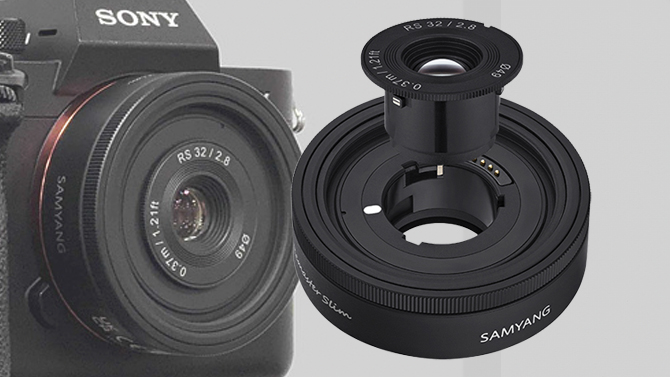Samyang's world-first 'optical exchange' autofocus lens might be the most innovative optic I've seen in years
The Remaster Slim is the company's smallest autofocus lens by some margin

Now this is what I call thinking outside the box: Samyang's new Remaster Slim for Sony is a tiny lens housing that lets you swap out the optical elements to enable different focal lengths, rather than needing entirely separate lenses.
As a housing, it packs all of the necessary electronic components for communication between camera and lens, including autofocus. Even with the optical element inserted it's one of the smallest autofocus lens systems around, measuring less than 0.8 inches / 2cm, while it weighs just 2.82oz / 80g.
The Remaster Slim is being launched with three different optical elements: a 32mm f/2.8 (pictured), a 28mm f/3.5, and a 21mm f/3.5. Each of these snaps easily into place magnetically, and Samyang says they produce "warm and profound images that cannot be imitated by the digital world, giving photos a natural and soft tone."
I'm not reading too much into the translation, although it does sound like the tiny Remaster Slim optics, which Samyang says have a "genuine analog sensibility", aren't quite as sharp as a dedicated prime lenses, such as Samyang's own 35mm f/2.8 (pictured below alongside the Remaster Slim), which was previously its smallest autofocus lens.


Still, what you do get is a genuinely tiny autofocus lens that looks like an ideal pairing with a travel camera such as the Sony A7C II. And instead of carrying multiple prime lenses for different scenarios, you can just keep the housing in place on the camera and pack the tiny optical element units instead, which are also quicker to swap out than standard lenses.
The Remaster Slim is currently only available in Sony E-mount and is on backorder in South Korea (with the 32mm f/2.8 optic costing 308,000 won – that's around $230 / £200 / AU$400). There's no official word on availability for other markets, although Samyang is already asking for customer feedback regarding which other mounts it should make the innovative lens housing for, including L-mount and Fujifilm X-mount.

Is this the lens innovation you actually need?
In theory, the Remaster Slim is sound. Most photographers are carrying around multiple lenses, doubling up on physical components such as the housing, autofocus motors and lens mount. So why not just pack that hardware once in a housing that can host multiple optical elements instead?
Get daily insight, inspiration and deals in your inbox
Sign up for breaking news, reviews, opinion, top tech deals, and more.
Using one lens housing for multiple optical elements that offer different looks also makes practical sense for creatives mounting gear to a gimbal – because there's no need to recalibrate the gimbal for different weight lenses each time. The quick and easy magnetic mounting of the optical units further increases the Remaster Slim appeal.
However, I'm not sure if the Remaster Slim is genuinely useful. It's clearly designed for portability over outright quality, plus there are practical limitations. I doubt that it's possible for Samyang to create any other optics that could squeeze into the Remaster Slim beyond the three everyday lenses on offer, all of which are fairly similar. Clearly, the Remaster Slim couldn't house a zoom lens, a larger-aperture prime lens like a f/1.4, or a telephoto lens.
In its current form, the Remaster Slim is probably confined to everyday prime lens focal lengths with a moderate maximum aperture – hardly the stuff to excite serious photographers.
The idea has potential, though, and Samyang could well launch a larger Remaster Slim housing in the future that's able to house different lenses, including telephoto optics. But until then, I'm filing this one under the innovations that I don't really need.
You might also like

Tim is the Cameras editor at TechRadar. He has enjoyed more than 15 years in the photo video industry with most of those in the world of tech journalism. During his time as Deputy Technical Editor with Amateur Photographer, as a freelancer and consequently editor at Tech Radar, Tim has developed a deeply technical knowledge and practical experience with cameras, educating others through news, reviews and features. He’s also worked in video production for Studio 44 with clients including Canon, and volunteers his spare time to consult a non-profit, diverse stories team based in Nairobi. Tim is curious, a keen creative, avid footballer and runner, and moderate flat white drinker who has lived in Kenya and believes we have much to enjoy and learn from each other.